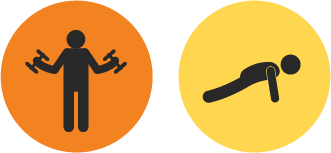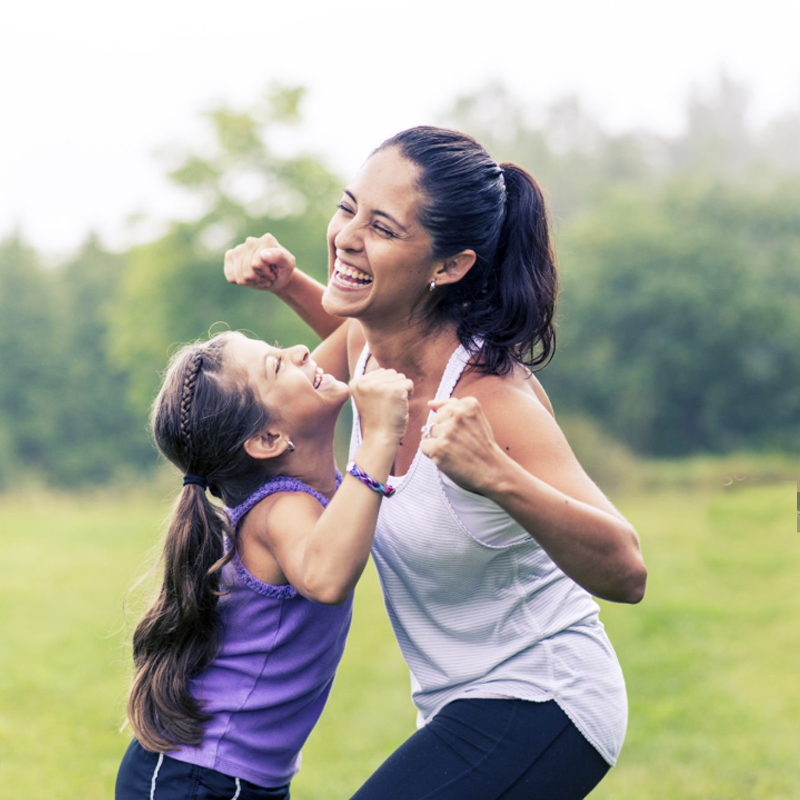Walk. Run. Dance. Play.
We all know physical activity helps us stay healthy. But finding time to move more and sit less isn’t always easy. Fortunately, we have some tips, tricks, tools, and suggestions to help your family set goals and stay motivated.
Sitting for long periods of time (being sedentary) is bad for our health. So, we need to find ways to move—even just a little more throughout the day—because it can have big health benefits that start almost immediately.
Anything that gets your heart beating faster counts and can make daily life better. For example, a quick 10-minute walk or trip up and down the stairs can:
- Boost your mood
- Sharpen your focus
- Reduce stress and anxiety
- Reduce blood pressure
- Improve your quality of sleep
- Improve insulin sensitivity
Sounds good, right? Here are some guidelines to keep in mind:
Adults need:
Aerobic Activity
150 minutes or 2.5 hours of moderate aerobic activity per week. If you prefer vigorous aerobic activity (like running) aim for at least 75 minutes per week.

Muscle-strengthening Activity
At least 2 days per week, do activities that make your muscles work harder than usual.

Kids (6-17) need:
Aerobic Activity
- 60 minutes of moderate-intensity aerobic activity. Anything that gets their heart beating faster counts.
- At least 3 days per week, encourage them to step it up to vigorous-intensity, so they’re breathing fast and their heart is pounding.

Muscle and Bone-strengthening Activity
At least 3 days per week, as part of their daily 60 minutes of physical activity. Anything that makes their muscles work harder counts toward muscle-strengthening—like climbing, swimming, push-ups or pull-ups.
Bones need pressure to get stronger so weight-bearing activities like running or jumping count as bone-strengthening activities.
But did you know that it can help them feel better right away? For kids ages 6-17, just 60 minutes of activity every day helps kids:
- Sleep better
- Get better grades
- Relax
- Improve their mood
- Increase their self-confidence
And, it doesn’t have to be all at once. A few minutes here and there throughout the day can really add up. Here are a few suggestions to get them moving:
- Walk to school or the bus stop
- Dance around the living room
- Play tag with friends
- Swing on the monkey bars
- Ride bikes to the park
- Walk the dog
- Join a sport or dance team
Talk to your kids about what they want to do to be more active, help them set their own goals, and encourage a routine.
Don’t forget the little ones…
Even the youngest children—ages 3 through 5—will benefit from regular physical activity. Preschool-aged children should be active throughout the day. Starting this habit early helps with growth and development and establishes a routine they can continue as they grow older. Parents and adults caring for children this age should encourage active play (light, moderate, or vigorous intensity) and aim for at least 3 hours per day.
Make a plan to stay on track
Now that you know what you need to do to stay physically active—let’s set some goals!
The key is to choose activities you enjoy. Mix it up and start out slow—especially if you’ve been inactive for a while. Remember, any amount of physical activity has health benefits.
The Move Your Way Activity Planner can help you choose the activities you want to do, set weekly goals and will give you personalized tips to help you stay motivated. Once you have your plan set up, be sure to share it with friends and family to help keep you on track!
Find more physical activity resources specifically for:
- Older adults
- Pregnant women & new moms
- People with disabilities
- People with health conditions

